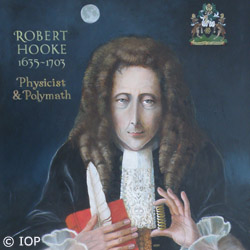New portrait establishes Hooke's rightful place in the history books
While the history books have been kind to Isaac Newton, crediting him favourably for his work on the theory of gravity, his contemporary Robert Hooke was for many years written off as a jealous scientist who disputed Newton's theories. But this was only part of the story and in recent years the scientific community has woken up to the fact that Hooke was in fact one of the great Enlightenment scientists. In an effort to further correct the skewed vision of history that proliferated for so long and give Hooke credit where credit is due, the Institute of Physics (IOP) in the United Kingdom has hung a new painting of the often forgotten scientist at its London headquarters. The painting is the work of history artist Rita Greer who started her 'Robert Hooke project' in 2003. Her aim was to set the record straight by chronicling the life of the scientist. 'Robert Hooke, brilliant, ingenious seventeenth century scientist was brushed under the carpet of history by Sir Isaac Newton and his cronies. When he had his Tercentenary there wasn't a single memorial to him anywhere. I thought it disgraceful as Hooke did many wonderful things for science,' comments Rita Greer. 'I have been working on a project to put him back into history where he belongs - up with the greats. I have been on the project for eight years and this portrait for IOP is no.8 in the series, with others memorials already in place at a range of high-profile locations in both Oxford and London.' But painting Hooke was no easy task as no visual record of what the scientist looked like has survived; it is widely believed that after Hooke's death in 1703 Newton had the only portrait of him burnt in a fit of jealousy. Greer has used written sources to create a likeness of Hooke with details fitting his position in the history of science. It was Hooke's dispute with Isaac Newton over credit for Newton's work on gravity that tainted over two hundred years of historical writing about Hooke. It is believed that he fought for greater credit than Newton offered for the guiding principles which were later detailed in Newton's work 'Principia'. However, regardless of the truth or otherwise to these scientific spats, there is no doubt that Hooke had a profound influence on the history of physics. He drew up the law of elasticity, now called 'Hooke's law', while working as Robert Boyle's assistant in 1660. Hooke's law states that the extension of a spring is in direct proportion to the load applied to it - a law which many materials obey and which culminated in the development of a balance spring. Balance springs subsequently enabled the development of the first watches. The new image being hung at the IOP shows Hooke holding a quill and a book in his right hand and a spring in his left hand that represents Hooke's law of elasticity. Hooke is also heralded for the construction of the vacuum pumps used in Boyle's gas law experiments, building some of the earliest Gregorian telescopes and observing the rotations of Mars and Jupiter, deducing the wave theory of light, and being the first to suggest that matter expands when heated and that air is made of small particles. As a polymath, Hooke was probably best known in his own lifetime for a publication called 'Micrographia' which contains his drawings from observations using a microscope, the most famous of which is a drawing of a flea. Former President of the IOP Sir Arnold Wolfendale FRS comments on the new painting's significance: 'Robert Hooke was a brilliant man of many parts of which one was physics. He was also remarkable for many advances and discoveries for which he did not receive adequate credit. With her fine portraits of Hooke, Rita Greer is going some way towards redressing the balance and bringing Hooke's image to a wider audience. I think that Hooke would have been pleased with her persistence.'For more information, please visit:Institute of Physics (IOP):http://www.iop.org/
Countries
United Kingdom



